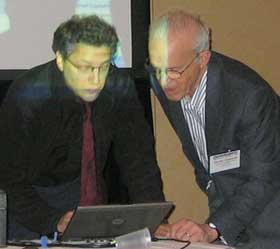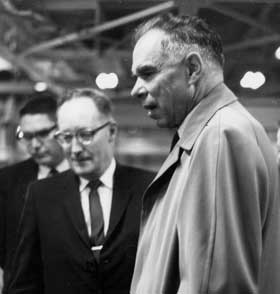Secrecy and Physics
Report on Forum-Sponsored Session: 2010 'April' Meeting
Dan Kleppner, Forum Chair

Photo courtesy of George Zimmerman.
Peter Galison (left) and Dan Kleppner (right) at the "Secrecy in Physics" session.
At the time of the Great War, when letters were the chief medium for sharing ideas, censorship was widespread. Letters were often marked "open" so that the censors would not damage them. Such pervasive censorship forced intellectuals to live under a cloud of oppression. When the United States entered the war it passed a Sedition Act to suppress opposition to the war, and an Espionage Act to prevent activities counter to U.S. interests. Neither Act, however, was aimed at technical information. Secrecy that focused on technical information, rather than political issues or diplomatic embarrassments, was a product of World War II with its nuclear and radar projects.
The Atomic Energy act of 1946, the McMahon Act, established secrecy policy for nuclear issues. Section 9 of the Act, as submitted to Congress in 1945, held that information not specifically classified could not be withheld. But the law, as signed by President Truman the following year, had been modified by Section 10, declaring that information was to be barred unless it was specifically declassified, introducing the concept that information is "born secret." There has been an ongoing struggle to find the appropriate balance between the level of secrecy needed to ensure security, and the information exchanges necessary for technical and scientific progress. This tension can cause mistrust between parties. Galison sees such mistrust as the underlying reason for the establishment of Livermore Labs as a separate national laboratory to carry forward the H-bomb project.
Despite emphasis on technical matters, after WWII secrecy has still been invoked to avoid embarrassment. Galison illustrated with the Reynolds case of the 1948 crash of a B-29 that carried several civilian scientists. The victims' families sued the government on grounds of incompetence. The case ended in a 1953 Supreme Court ruling, which favored the Air Force claim that matters of secrecy prevented them from sharing the accident report. The suit was dropped. By 2000, with the release of certain documents related to the crash, it was found out that the government's claim had no merit, and the case was pursued in 2003, when family members of the original plaintiffs petitioned the Supreme Court to re-open the case. That petition was denied, resulting in new complaint filed in federal district court.
Finally, Galison spoke briefly about making the film Secrecy, which was shown at the meeting. Making a film about topics one cannot talk about presents obvious challenges! The film addresses the problem of balancing national security and democracy, and questions of how information can flow, be sequestered, or be shared.

Photo courtesy of Emilio Segrè Visual Archive.
Glenn Seaborg (right).
The landscape of secrecy includes broad categories of restricted but not classified information, including SUTI (sensitive unclassified technical information), UCNI (unclassified controlled nuclear information) and more than 100 other categories. In three years these will be replaced by a single category, Controlled Unclassified Information, or CUI. President Obama, in Executive Order 3526, includes two references to classified information policy on scientific and technical matters. One broad category requires that information may be classified only if its disclosure could cause damage. The second states that basic research not clearly related to national security cannot be classified. A presidential directive issued in the Reagan administration requires that the products of fundamental research shall remain unrestricted if possible, and if they must be controlled the process can only be done by national security classification.
Aftergood described several recent examples showing how the impact of the government secrecy system ebbs and flows. The Invention Secrecy Act of 1951 asserts the right of the government to control disclosure of privately generated information. The Act permits any one of several Presidentially-selected governmental agencies to classify patents whenever they believe disclosure would be detrimental to national security. At the end of last year, over 5000 inventions had been controlled, including 103 new ones in 2009. The potential conflict between this law and the First Amendment has not been tested.
Another problem occurs when secrecy interferes with pubic deliberation of scientific issues. Aftergood has a pending Freedom of Information Act request for information on the list of inventions, but there has so far been no response. Last year the Jasons carried out an unclassified study on science and technology for national security. Although the study was unclassified, the Pentagon has refused to release the report on the grounds that it is "deliberative." Another case of official secrecy interfering with public debate concerns a series of studies by the Department of Energy on the costs and risks of nuclear disarmament. The Federation of Atomic Scientists is actively concerned with disarmament, but has been denied permission to see the studies. The Defense Technical Information Center announced last fall that it would offer a portal for providing information on publicly supported fundamental research, but only to classified users. This seems to conflict with the presidential directive that stipulates only through national security classification can information be restricted.
A final episode that Aftergood related concerned a Brazilian physicist who, last April, published a 400-page volume on the physics of nuclear explosives. Most of the book is a digest of the large quantity of public literature already available on the subject, but the author used unclassified computer models to do numerical simulations of a U.S. thermonuclear weapon. The International Atomic Energy Agency urged the Brazilian government to restrict the book. Instead, the government defended his right to work, the press took up the case as a tribute to Brazilian science, and the author became a public hero.
William Happer, in his talk "How Much Secrecy?" asserted that, although secrecy can be vital, extraordinary care is needed to get it right: not too much, not too little. From living systems to large technical projects, all systems require feedback to function. However, secrecy interferes with feedback, resulting in projects that can "run amuck." Happer witnessed examples of this throughout his experience as a Jason, and while at the Department of Energy. Program managers are protective of their programs and are often unwilling to let others have a look. Feedback is best provided by review committees. However, members of review committees are often part of a small community—or part of the program itself. Such a practice contradicts James Madison's admonition that "No man should be a judge in his own cause." Happer contrasted the successful operation of the nation's two weapons laboratories that benefit from independent and "vigorous" review by the competing laboratory, with failures in Department of Defense and Central Intelligence Agency programs that lack independent reviews. He recommended the film Secrecy by Peter Galison for elaboration of these issues.
Happer then turned to a matter of secrecy by non-governmental agenda-driven organizations, citing the New York Times' failure to report the mass starvation in the Ukraine in the early 1930s and Stalin's Moscow Trials of the late 1930s. Happer's chief concern today is the withholding of scientific data with respect to climate change. Tapes from the Climate Research Unit of the University of East Anglia that were recently made public provided evidence that data was intentionally withheld from "politically incorrect" groups. This was consistent with Happer's own experience that skeptical scientists who attempted to get climate change data could be "stiff-armed." Access to the data would permit the APS to carry out an independent study on climate change. Happer urged the APS to set aside the "mainstream media" position that it recently endorsed and establish an independent position based on its own analysis of the data.
Note Added: This article represents the views of the author, which are not necessarily those of the FHP or APS.
